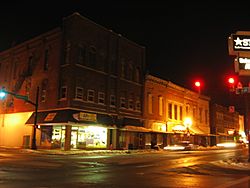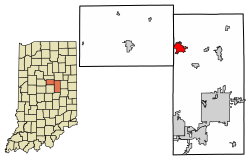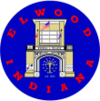Elwood, Indiana facts for kids
Quick facts for kids
City of Elwood
|
|||
|---|---|---|---|

Elwood Downtown Historic District at night
|
|||
|
|||

Location in Madison County and Tipton County, Indiana
|
|||
| Country | United States | ||
| State | Indiana | ||
| Counties | Madison, Tipton | ||
| Townships | Pipe Creek, Duck Creek, Madison | ||
| Area | |||
| • Total | 3.97 sq mi (10.28 km2) | ||
| • Land | 3.97 sq mi (10.28 km2) | ||
| • Water | 0 sq mi (0.00 km2) | ||
| Elevation | 863 ft (263 m) | ||
| Population
(2020-)
|
|||
| • Total | 8,410 | ||
| • Density | 2,119.46/sq mi (818.35/km2) | ||
| Time zone | UTC-5 (EST) | ||
| • Summer (DST) | UTC-4 (EDT) | ||
| ZIP code |
46036
|
||
| Area code(s) | 765 | ||
| FIPS code | 18-21070 | ||
| GNIS feature ID | 2394680- | ||
Elwood is a city located in Madison and Tipton counties in the state of Indiana, United States. Most of the city is in Madison County. This part is also near the larger Indianapolis–Carmel–Anderson metropolitan area. In 2020, about 8,410 people lived in Elwood.
Contents
History of Elwood
Elwood was first established in 1853 and was called "Duck Creek." It officially became a city in 1891.
The first post office opened in 1855, also named "Duck Creek." It was later renamed Elwood in 1869. The first railroad arrived in Elwood in 1857, helping the town grow.
The Big Political Rally of 1940
On August 17, 1940, a huge political event happened in Elwood. The Republican National Committee held a special ceremony to announce that Wendell Willkie, who was born in Elwood, would be their candidate for President. He was running against Franklin Roosevelt.
This event took place at Callaway Park, just outside the city. An amazing 150,000 people came to see it! This was the largest political rally in American history at that time. People arrived in 60,000 cars, 63 special trains, 300 Pullman cars, and 1,200 buses.
The Indiana University band led a parade, and 249 other bands also marched. When Willkie appeared, the crowd cheered for ten minutes before he could even start his speech. However, the weather was very hot, and some people felt Willkie's speech was not very exciting.
Elwood's Past: A "Sundown Town"
By the 1880s, Elwood had a sad history as a "sundown town." This meant that Black people were not allowed to live in the town. In 1897, a newspaper reported that for over twenty years, Black people were not "permitted to remain any length of time" in Elwood. This rule continued for most of the 20th century.
During the large Wendell Willkie rally in 1940, some important Black reporters were allowed to stay briefly in a downtown hotel. However, other Black visitors could not stay overnight because of the town's "sundown" rules. Signs at the city limits also discouraged Black people from attending the rally at all. These rules and signs stayed in place for many decades.
By the late 1900s, these rules were not as strictly enforced. Still, as recently as 2002, some law enforcement officers in nearby Marion thought Elwood was still not welcoming to Black people. In 2015, after another Indiana town talked about its own "sundown town" history, Elwood's past became a topic of discussion. The mayor of Elwood said he didn't know about these past rules. He stated he would address them if they were still affecting Elwood's reputation today.
Geography of Elwood
Elwood is located in the northwestern part of Madison County. A small part of the city also extends into Tipton County.
Major Roads and Waterways
Indiana State Road 28 runs through Elwood, known as Main Street. It goes east about 9 miles to Alexandria and west about 10 miles to Tipton. State Road 13 (Anderson Street) crosses SR 28 in the center of Elwood. It goes north about 10 miles to Point Isabel and south about 15 miles to Lapel.
State Road 37 passes through the southeast edge of the city. It leads northeast about 23 miles to Marion and southwest about 20 miles to Noblesville. Anderson, which is the county seat of Madison County, is about 17 miles southeast of Elwood.
The U.S. Census Bureau states that Elwood covers a total area of 3.97 square miles, all of which is land. Big Duck Creek flows through the middle of the town. This creek flows southwest and eventually joins the White River near Strawtown.
Elwood's Climate
| Climate data for Elwood, IN (1981-2013 normals-Extremes 1948–2013) | |||||||||||||
|---|---|---|---|---|---|---|---|---|---|---|---|---|---|
| Month | Jan | Feb | Mar | Apr | May | Jun | Jul | Aug | Sep | Oct | Nov | Dec | Year |
| Record high °F (°C) | 69 (21) |
74 (23) |
84 (29) |
88 (31) |
94 (34) |
99 (37) |
103 (39) |
99 (37) |
101 (38) |
92 (33) |
83 (28) |
72 (22) |
103 (39) |
| Mean maximum °F (°C) | 56 (13) |
61 (16) |
74 (23) |
81 (27) |
87 (31) |
92 (33) |
94 (34) |
93 (34) |
90 (32) |
82 (28) |
71 (22) |
58 (14) |
94 (34) |
| Mean daily maximum °F (°C) | 33.7 (0.9) |
38.2 (3.4) |
49.7 (9.8) |
62.2 (16.8) |
72.7 (22.6) |
81.4 (27.4) |
84.5 (29.2) |
83.0 (28.3) |
77.1 (25.1) |
64.6 (18.1) |
51.7 (10.9) |
37.7 (3.2) |
61.4 (16.3) |
| Daily mean °F (°C) | 25.0 (−3.9) |
29.4 (−1.4) |
39.2 (4.0) |
50.3 (10.2) |
61.1 (16.2) |
70.2 (21.2) |
73.4 (23.0) |
71.4 (21.9) |
64.6 (18.1) |
52.5 (11.4) |
41.5 (5.3) |
29.7 (−1.3) |
50.7 (10.4) |
| Mean daily minimum °F (°C) | 16.5 (−8.6) |
20.4 (−6.4) |
28.7 (−1.8) |
38.4 (3.6) |
49.7 (9.8) |
59.0 (15.0) |
62.3 (16.8) |
59.7 (15.4) |
52.0 (11.1) |
40.5 (4.7) |
31.9 (−0.1) |
21.6 (−5.8) |
40.1 (4.5) |
| Mean minimum °F (°C) | −4 (−20) |
−1 (−18) |
12 (−11) |
24 (−4) |
35 (2) |
46 (8) |
51 (11) |
48 (9) |
37 (3) |
27 (−3) |
18 (−8) |
2 (−17) |
−4 (−20) |
| Record low °F (°C) | −24 (−31) |
−23 (−31) |
−10 (−23) |
12 (−11) |
26 (−3) |
36 (2) |
43 (6) |
37 (3) |
28 (−2) |
17 (−8) |
−5 (−21) |
−20 (−29) |
−24 (−31) |
| Average precipitation inches (mm) | 2.49 (63) |
2.17 (55) |
3.00 (76) |
3.78 (96) |
4.24 (108) |
4.45 (113) |
4.33 (110) |
3.50 (89) |
3.50 (89) |
2.98 (76) |
3.96 (101) |
3.23 (82) |
41.63 (1,058) |
| Average snowfall inches (cm) | 5.0 (13) |
4.8 (12) |
1.1 (2.8) |
trace | 0.0 (0.0) |
0.0 (0.0) |
0.0 (0.0) |
0.0 (0.0) |
0.0 (0.0) |
trace | 0.1 (0.25) |
4.8 (12) |
15.8 (40.05) |
| Average extreme snow depth inches (cm) | 2 (5.1) |
4 (10) |
1 (2.5) |
0 (0) |
0 (0) |
0 (0) |
0 (0) |
0 (0) |
0 (0) |
0 (0) |
0 (0) |
2 (5.1) |
4 (10) |
| Average precipitation days (≥ 0.01 Inches) | 10 | 8 | 11 | 11 | 12 | 10 | 10 | 8 | 8 | 9 | 11 | 11 | 119 |
| Average snowy days (≥ 0.1 Inches) | 4 | 3 | 1 | 0 | 0 | 0 | 0 | 0 | 0 | 0 | 0 | 3 | 11 |
| Source: NOAA | |||||||||||||
Elwood's Population and People
| Historical population | |||
|---|---|---|---|
| Census | Pop. | %± | |
| 1870 | 310 | — | |
| 1880 | 751 | 142.3% | |
| 1890 | 2,284 | 204.1% | |
| 1900 | 12,950 | 467.0% | |
| 1910 | 11,028 | −14.8% | |
| 1920 | 10,790 | −2.2% | |
| 1930 | 10,685 | −1.0% | |
| 1940 | 10,913 | 2.1% | |
| 1950 | 11,362 | 4.1% | |
| 1960 | 11,793 | 3.8% | |
| 1970 | 11,196 | −5.1% | |
| 1980 | 10,867 | −2.9% | |
| 1990 | 9,494 | −12.6% | |
| 2000 | 9,737 | 2.6% | |
| 2010 | 8,614 | −11.5% | |
| 2020 | 8,410 | −2.4% | |
| U.S. Decennial Census | |||
Population in 2010
According to the census from 2010, there were 8,614 people living in Elwood. These people made up 3,455 households, with 2,265 of them being families. The city had about 2,285 people per square mile.
Most of the people in Elwood (96.7%) were White. A small number were African American (0.2%), Native American (0.2%), or Asian (0.3%). About 3.3% of the population identified as Hispanic or Latino.
Out of all the households, 33.1% had children under 18 living there. About 44.8% were married couples. The average household had 2.49 people, and the average family had 3.02 people.
The average age of people in Elwood was 38.6 years old. About 25.2% of residents were under 18. Also, 14.1% were 65 years or older. The population was almost evenly split between males (48.7%) and females (51.3%).
Community and Culture in Elwood
Elwood celebrates its history with natural gas and glass each year. They hold an annual Glass Festival every third weekend in August.
Around the turn of the 20th century, many Welsh immigrant families moved to Elwood. They also settled in nearby towns like Anderson and Gas City.
Elwood has a public library that is part of the North Madison County Public Library System.
The Elwood Downtown Historic District is an important area in the city. It was added to the National Register of Historic Places in 2002 because of its historical value.
Famous People from Elwood
- David Canary, an actor
- Jared Carter, a poet
- Joseph Clancy, who was the 24th director of the U.S. Secret Service
- James J. Davis, a U.S. Secretary of Labor and a U.S. senator from Pennsylvania
- Ryan Keene (also known as "Fry Guy"), a computer hacker
- Don Mellett, a newspaper editor
- John Mengelt, a professional basketball player in the NBA
- Philip Sharp, a congressman from Indiana
- Ray Still, a modern classical oboe player
- Wallace D. Wattles, a writer
- Edward Willkie, an Olympic wrestler
- Wendell Willkie, who ran for President as a Republican in 1940
See also
 In Spanish: Elwood (Indiana) para niños
In Spanish: Elwood (Indiana) para niños



